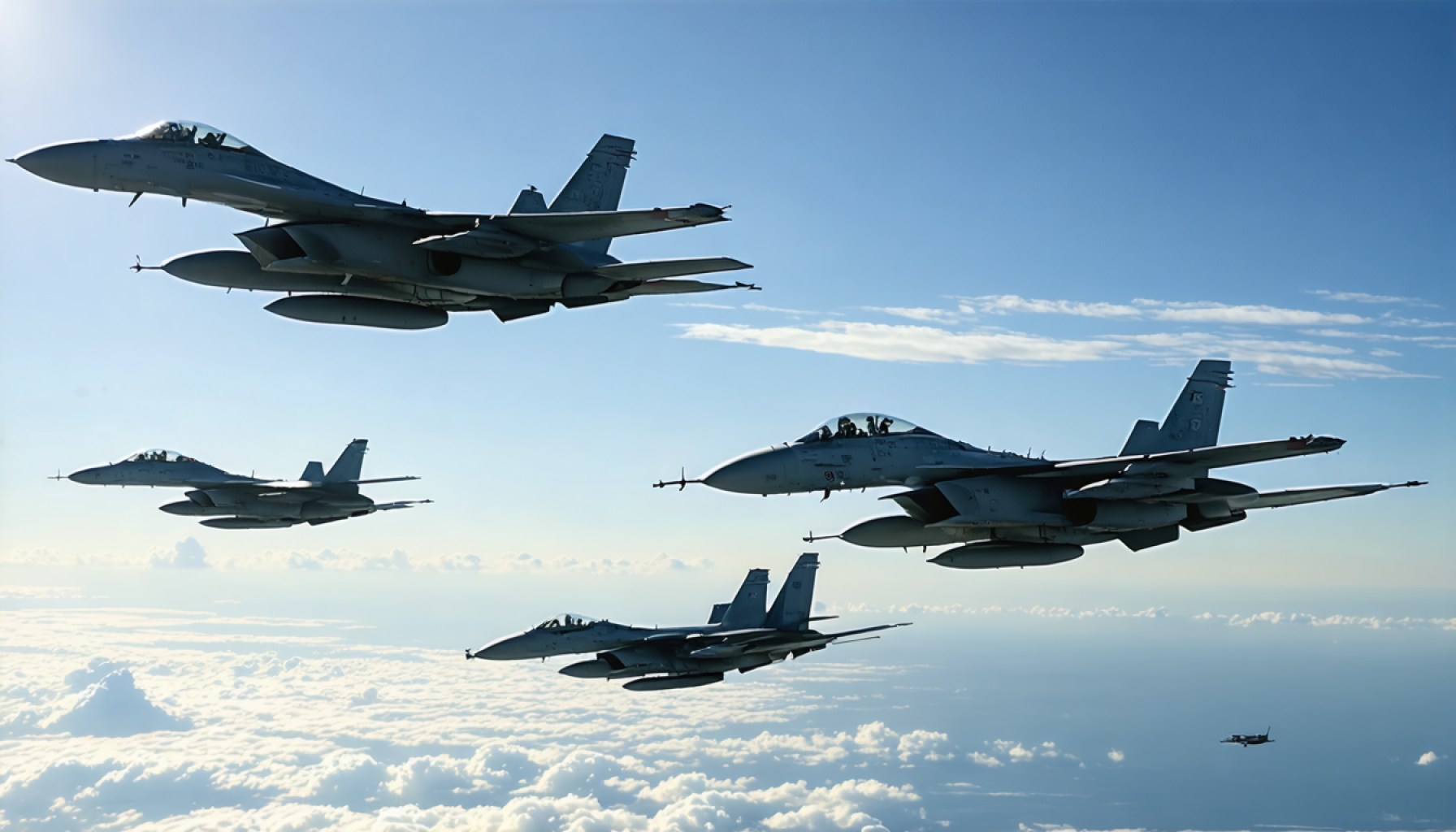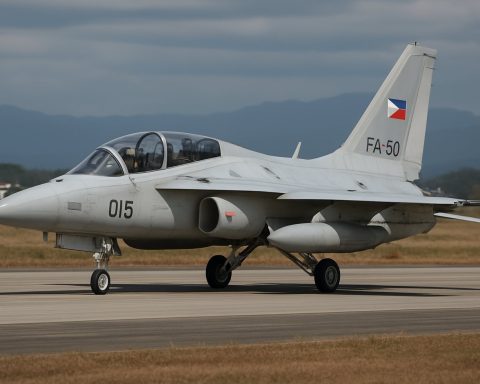- An increase in Chinese and Russian military flights near Japan and South Korea highlights the tense geopolitical environment in the region.
- Japan’s Defense Ministry has reported 704 scrambles in the past fiscal year, responding to incursions near its airspace.
- Chinese aircraft triggered 464 alerts, and Russian sorties accounted for 237, marking a rise in aerial confrontations.
- These flights are part of a strategy by China and Russia to test Japan’s defenses and challenge the status quo around the first island chain.
- Japan’s air force responds with increased vigilance, aiming to protect its airspace amid rising tensions.
- Chinese drones are becoming more frequent, indicating China’s expanded use of technological capabilities.
- The situation underscores the importance of Japan and its allies maintaining diplomatic and military readiness in the Asia-Pacific region.
- The continued military activity in the area is shaping the future security dynamics of the region.
Dark silhouettes of military jets carve through the skies near Japan and South Korea, a stark reminder of the geopolitical dance in one of the world’s most strategically tense regions. The dramatic increase in military flights by Chinese and Russian forces near these U.S. allies has stirred both air and diplomatic currents, as new data reveals staggering figures from the Japanese Defense Ministry.
Japan, a critical anchor in the United States’ maritime buffer against China and Russia, is a centerpiece of this high-stakes chessboard. The island nation’s Defense Ministry has scrambled its jets 704 times in the past fiscal year as Chinese and Russian aircraft approached its airspace—marking a rise in aerial confrontations that underline the fraught nature of the region’s security dynamics.
Vivid, colorful maps paint a story of increased incursions: Chinese aircraft accounted for 464 of these alerts, while Russian sorties comprised another 237. The figures reflect a sophisticated pattern of maneuvers covering zones stretching from the Philippine Sea to the East China Sea, brushing the edges of Japan’s air defense identification zone. The footprints of Chinese and Russian flights, coded in bold red and orange, trace a relentless rhythm across the blue expanse of the Pacific.
These flights are not mere posturing; they form part of Beijing and Moscow’s strategy to challenge the status quo around the first island chain—a geopolitical concept devised during the Cold War. By charting airspace close to Japan, China and Russia not only test Japan’s defense mechanisms but also the resolve of American defense postures in Asia.
Amid these provocations, Japan’s air force interceptors thunder across skies in frequent scrambles. Despite their vigilance, violations have occurred, with Chinese and Russian planes momentarily brushing against Japanese airspace—each episode a delicate dance avoiding the thin line that separates peace and conflict.
Yet, it’s not just conventional aircraft causing alarm; the iridescent wings of Chinese drones have become increasingly frequent visitors. Interceptions have surged, showcasing a willingness by Beijing to deploy even the more sinister side of its technological prowess over these contested skies.
In the face of this airborne chess match, Japan’s self-defense forces stand resolute. Their mission is clear: to protect the country’s airspace, providing a shield for those beneath their watch. The backdrop, however, is harsh—the most challenging security landscape since World War II casts a long shadow over the islands.
The skies thrum with tension, as the likelihood of continued military flights seems inevitable. With U.S. forces also navigating these strategic waters, encounters with Chinese and Russian military grow ever more frequent. It’s a silent testament to the vulnerabilities and the volatile choreography of power that define modern geopolitical strategy.
The takeaway amid these stormy skies is unmistakable: Japan, alongside its allies, must remain vigilant and versatile. The stakes are high, and the need for diplomatic dexterity and military readiness has never been more acute. Japan’s skies are not just a theater of conflict but a crucible shaping the future of Asia-Pacific security.
Tensions in the Skies: The Rising Geopolitical Dynamics in East Asia
Overview
The surge in military aircraft activities from China and Russia near Japan and South Korea highlights the increasing geopolitical tensions in East Asia. The situation, as reported by the Japanese Defense Ministry, underscores a growing strategic challenge that involves complex airspace defense identification tactics. Let’s delve deeper to explore additional dimensions, including expert predictions, regional security implications, and strategic responses.
Strategic Context and Implications
1. Regional Security Dynamics:
– Japan as a Strategic Anchor: Positioned as a pivotal buffer in U.S. maritime strategy, Japan plays a crucial role in containing Chinese and Russian ambitions in the Pacific. The increase in airspace incursions reflects an evolving and aggressive strategy from Beijing and Moscow to test both Japan’s and U.S. commitments.
– Geopolitical Chessboard: This modern theater of operations mirrors Cold War tactics, with China and Russia honing their prowess in what is metaphorically known as the “first island chain” strategy.
2. Technological Advancements:
– Drones and Unmanned Aerial Vehicles: China’s deployment of drones highlights a significant shift toward unmanned conflict strategies, leveraging technology for surveillance and reconnaissance while minimizing direct risks.
Market Forecasts & Industry Trends
1. Defense and Aerospace Sector Growth:
– An anticipated trend is the strengthening of Japan’s military expenditures, focusing on advanced radar systems, fighter jets, and drone countermeasures.
– The global military drone market is expected to expand significantly as geopolitical tensions inspire increased investments in surveillance technologies.
2. Collaborative Security Frameworks:
– Potential deepening of defense collaborations between Japan, South Korea, and other Quad countries (India, the U.S., and Australia) to counterbalance regional threats.
Expert Insights
1. Defense Experts’ Take:
– Analysts predict continued aerial challenges as part of broader strategic posturing by China and Russia.
– Recommendations include fortifying diplomatic channels alongside military preparedness to ensure robust responses to provocations.
Challenges and Controversies
1. Airspace Violations:
– Controversies arise over the legality and intent behind airspace incursions, with debates focusing on whether such actions breach international norms.
– Diplomatic efforts are essential to de-escalate potential conflicts resulting from borderline airspace violations.
2. Sustainability and Security Concerns:
– Continuous military flights pose environmental concerns, prompting discussions on sustainable practices even in defense sectors.
Practical Recommendations
1. Enhancing Diplomatic Channels:
– Engage in robust multilateral dialogues to address security concerns and reduce the risk of misunderstandings.
2. Military Readiness:
– Invest in modernizing air defense systems to counter drone threats effectively and increase interception capabilities.
3. Public Awareness and Education:
– Improve public communication to better understand the nuances of geopolitical threats and governmental responses.
Conclusion
The alarming rise in military flights near Japan and South Korea is a testament to the delicate power dynamics shaping Asia-Pacific’s future. Vigilance, strategic partnerships, and diplomatic agility are paramount as regional players navigate this complex geopolitical reality. Nations involved must employ a balanced approach of strength and communication to maintain stability and peace.
For further updates on regional security news, visit Reuters and BBC.







